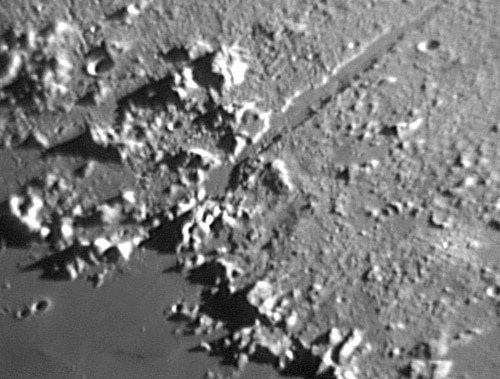Difference between revisions of "April 11, 2004"
| (2 intermediate revisions by the same user not shown) | |||
| Line 1: | Line 1: | ||
__NOTOC__ | __NOTOC__ | ||
=Valley of the Alpes= | =Valley of the Alpes= | ||
| + | <!-- Start of content --> | ||
<table width="640" border="0" align="center" cellpadding="6" cellspacing="2"> | <table width="640" border="0" align="center" cellpadding="6" cellspacing="2"> | ||
<tr> | <tr> | ||
| Line 41: | Line 42: | ||
[http://www.lpi.usra.edu/research/lunar_orbiter/images/img/iv_115_h3.jpg Lunar Orbiter IV View]<br> | [http://www.lpi.usra.edu/research/lunar_orbiter/images/img/iv_115_h3.jpg Lunar Orbiter IV View]<br> | ||
[http://nssdc.gsfc.nasa.gov/imgcat/html/object_page/lo5_m102.html Lunar Orbiter V View]</p> | [http://nssdc.gsfc.nasa.gov/imgcat/html/object_page/lo5_m102.html Lunar Orbiter V View]</p> | ||
| − | <p | + | <p><b>Yesterday's LPOD:</b> [[April 10, 2004|Another Farside View]] </p> |
| + | <p><b>Tomorrow's LPOD:</b> [[April 12, 2004|Procellarum Volcanic Group]] </p> | ||
</td> | </td> | ||
</tr> | </tr> | ||
| Line 57: | Line 59: | ||
<!-- Cleanup of credits --> | <!-- Cleanup of credits --> | ||
<p> </p> | <p> </p> | ||
| − | + | <!-- End of content --> | |
| − | + | {{wiki/ArticleFooter}} | |
| − | |||
| − | |||
| − | <!-- | ||
| − | |||
| − | |||
| − | |||
| − | |||
| − | |||
| − | |||
| − | |||
Latest revision as of 19:15, 7 February 2015
Valley of the Alpes
Image Credit: Richard Bosman |
|
Valley of the Alpes The Moon is full of oddities, unique features that test our imagination in trying to understand their origins. The Alpine Valley, discovered by the Italian priest and astronomer Francesco Bianchini in 1727, is such a landform. Like a Suez Canal, it cuts thru rubbly and blocky Imbrium ejecta, linking Mare Imbrium to Mare Frigoris - someday it may be a convenient short cut, clogged with lunar transport vehicles. The Alpine Valley is radial to Imbrium and presumably is intimately related to that basin's formation. But its great length (190 km) and narrow width (10 km) make it unlikely to be a gash plowed out by ejecta. Also notice that the two sides don't fit together - the southern edge is very straight, with offsets at both ends. The opposite edge has a ragged and rounded serrated appearance. The edges are rather abrupt, as if the ground cracked open along both sides and the middle dropped down - a graben. Just visible in this image is the famously elusive central rille. The linked Orbiter V image shows that the rille is unusual. It has a number of straight lengths and kinks that mimic offsets of the valley walls. Presumably the rille and smooth lava floor were emplaced significantly after the valley formed. Technical Details: Celestron 11 , mounted EQ 6; 2x Barlow and ToUcam Pro. The moon was about 8 days old and the seeing on 3/29/2004 was not very good.The seeing was like big waves, from bad to moderate seeing.Related Links: Yesterday's LPOD: Another Farside View Tomorrow's LPOD: Procellarum Volcanic Group |
Author & Editor:
Charles A. Wood
COMMENTS?
Register, Log in, and join in the comments.




